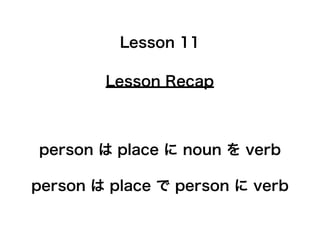
L11 grammar note
- 1. Lesson Recap Lesson 11 person は place に noun を verb person は place で person に verb
- 2. In lesson 10 we learned basic action verbs with direct objects, and the particle で indicates where the action described by the verb takes place. In this lesson we learn verbs that take transferable/transmittable objects and information to someone or some place as below; verb。 The particle に indicates a person or place that the objects are directly delivered or transmitted to, by the verb. person は w a o object を Verbs that take Transferable/Transmittable Objects and information n i person にplace n i
- 3. PRESENT FROMPRESENT FROM PAST FORMPAST FORM aff. neg. aff. neg. telephone でんわをします denwa o shimasu でんわをしません denwa o shimasen でんわをしました denwa o shimashita でんわをしませんでした denwa o shimasendeshita write かきます kakimasu かきません kakimasen かきました kakimashita かきませんでした kakimasendeshita send おくります okurimasu おくりません okurimasen おくりました okurimashita おくりませんでした okurimasendeshita meet あいます aimasu あいません aimasen あいました aimashita あいませんでした aimasendeshita Conjugation of Verbs
- 4. V-46 L4 !"!"# L6 $%&'()# # *+,&'() スミスさんは メアリーさんに でんわを しました。 Mr. Smith telephoned to Mary. sumisu san wa mearii san ni denwa o shimashita * *We also say でんわを かけます which is same as to make a phone call . かけます originally means to hang as they say hang up as in English. denwa o kakemasu
- 5. スミスさんは メアリーさんに てがみを かきました。 Mr. Smith wrote a letter to Mary. sumisu san wa mearii san ni tegami o kakimashita V-17 L4 !"# # $" メアリーさんは スミスさんに *へんじを かきました。 Mary wrote a reply to Mr. Smith. mearii san wa sumisu san ni henji o kakimashita * へんじ means a reply . henji
- 6. V-126 L14 !"# # $%" スミスさんは メアリーさんに メールを おくりました。 Mr. Smith sent an e-mail to Mary. sumisu san wa mearii san ni meeru o okurimashita メアリーさんは アメリカに *にもつを おくりました。 Mary sent a package to the U.S.A. mearii san wa amerika ni nimotsu o okurimashita * にもつ means a package or baggage. nimotsu
- 7. V-14 L4 !"# # $" スミスさんは あした グリーンさんに あいます。 Mr. Smith meets with Mr. Green tomorrow. sumisu san wa ashita guriin san ni aimasu メアリーさんは きのう きっさてんで ともだちに あいました。 Mary met with a friend at the coffee shop yesterday. mearii san wa kinou kissaten de tomodachi ni aimashita The verb あいます , people deliver by themselves to meet with someone.
- 8. You can add a frequency adverb such as よく(often) and ときどき (sometimes) to a sentence to describe how often you do something. Just like in English, a Japanese adverb comes immediate before a verb in a sentence, however, the object comes between if the verb is transitive. ばんごはんの あと、 あまり テレビを みません。 ばんごはんの あと、 ぜんぜん テレビを みません。 bangohan no ato amari terebi o mimasen. bangohan no ato zenzen terebi o mimasen. Frequency Adverbs ばんごはんの あと、 よく テレビを みます。 bangohan no ato yoku terebi o mimasu. (I often watch TV after dinner.) When you describe infrequent activities with あまり(not very often) and ぜん ぜん(never) , these adverbs anticipate the negative at the end of the sentence. In other words, you need to conclude the sentence with ません or ませんでした . (I don t watch TV after dinner very often.) (I never watch TV after dinner/ I don t watch TV after dinner at all .)
- 9. ばんごはんの あと、 いつも テレビを みます。100% Frequency Adverbs いつも/ always よく/ often ときどき/ sometimes たまに/ occasionally あまり∼ません/ not very often ぜんぜん ∼ません/ never ばんごはんの あと、 よく テレビを みます。 ばんごはんの あと、 ときどき テレビを みます。 ばんごはんの あと、 たまに テレビを みます。 ばんごはんの あと、 あまり テレビを みません。 ばんごはんの あと、 ぜんぜん テレビを みません。 itsumo bangohan no ato itsumo terebi o mimasu. I ・・・ watch TV after dinner. yoku bangohan no ato yoku terebi o mimasu. tokidoki bangohan no ato tokidoki terebi o mimasu. tamani bangohan no ato tamani terebi o mimasu. amari∼masen bangohan no ato amari terebi o mimasen. zenzen ∼ masen bangohan no ato zenzen terebi o mimasen.0%
- 10. You can ask questions with frequency adverbs as below; いいえ、 あまり みません。 いいえ、 ぜんぜん みません。 iie amari mimasen. iie zenzen mimasen. Q & A with Frequency Adverbs ばんごはんの あと、 よく テレビを みますか。 bangohan no ato yoku terebi o mimasuka. ( Do you often watch TV after dinner? ) Even if you do not watch TV often after dinner, but you do sometimes, you still have to answer with はい/yes . As long as your frequency could be applied in the green zone on the previous page, your answer should start with はい/yes . (No, I don t watch very often.) (No, I never watch./ No, I don t watch at all .) はい、 ときどき みます。 hai tokidoki mimasu. ( Yes, I sometimes do.) If you do not watch TV very often after dinner, or you never do, you answer with いいえ/no . As long as your frequency could be applied in the red zone on the previous page, your answer should start with いいえ/no . はい、 たまに みます。 hai tokidoki mimasu. ( Yes, I sometimes do.)
